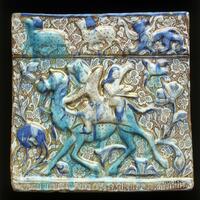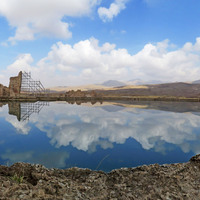Takht-e Soleyman
Type:
Palace complexes,
Temples,
Tiles
Date:
1270s (Ilkhanid summer palace)
Location or Findspot (Modern-Day Country):
Iran
Medium:
Lusterware
Description:
Takht-e Soleyman, in northwestern Iran, was an important pilgrimage destination, coronation site, and Zoroastrian fire temple. In the sixth century, the Sasanian shahanshah Khosrow I (r. 531–79) had the sixty-meter-high hill with its oval lake built up with monumental architecture. In the thirteenth century, Takht-e Soleyman became the summer palace of the Ilkhanid rulers, allowing them to forge a symbolic link with the prestige of the ancient Sasanian kings.
The Ilkhanid palace was adorned with tile revetments dated by inscription to the 1270s. A mold found during excavations of the site indicates that fritware tiles, used on the interior and exterior of the buildings, were likely produced locally. The glazing and metallic pigments used in the luster technique would have given the revetments a reflective, glittering quality. They include figural imagery was well as geometric designs and inscriptions. One of the tiles reproduced here, from a frieze at Takht-e Soleyman, depicts Bahram Gur out hunting with his favorite musician slave girl, Azadah (shown playing her harp on the back of the camel). The other has a dragon, a symbol of imperial power that Iran's Mongol rulers adopted from the Chinese.
The Ilkhanid palace was adorned with tile revetments dated by inscription to the 1270s. A mold found during excavations of the site indicates that fritware tiles, used on the interior and exterior of the buildings, were likely produced locally. The glazing and metallic pigments used in the luster technique would have given the revetments a reflective, glittering quality. They include figural imagery was well as geometric designs and inscriptions. One of the tiles reproduced here, from a frieze at Takht-e Soleyman, depicts Bahram Gur out hunting with his favorite musician slave girl, Azadah (shown playing her harp on the back of the camel). The other has a dragon, a symbol of imperial power that Iran's Mongol rulers adopted from the Chinese.
Relevant Textbook Chapter(s):
3,
9
Repository and Online Resources:
• The frieze tiles are now in the collection of London's Victoria and Albert Museum.
• Read more about tilework in the Ilkhanid Period on the website of the Metropolitan Museum.
• Visit the page for Takht-e Soleyman on UNESCO's World Heritage List.
Image Credits:
Wikimedia Commons, Victoria and Albert Museum, Navid Jamali




